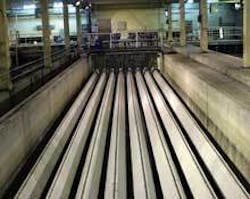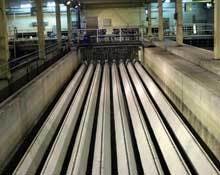Utility Retrofits Traveling Bridge Filters with Cloth Media Filters
Fox Metro Water Reclamation District in Oswego, IL, started up in the 1920s with a trickling filter system which treated an average daily flow of 8 mgd. Growth and new stringent effluent regulations during the 1960s and 1970s resulted in a major expansion and several upgrading projects for the plant. The upgrading projects included the installation of traveling bridge sand filters for tertiary filtration in the late 1970s, and conversion of the trickling filter system to an activated sludge treatment process in 1982.
Fox Metro’s service area continued to grow and currently services a population of almost 250,000 which includes the Aurora, Boulder Hill, Montgomery, Oswego, and Sugar Grove areas. To accommodate the growing community, the plant expanded its treatment capacity to an average daily flow of 42 mgd and peak flow of 85 mgd.
Fox Metro’s treatment scheme included traveling bridge sand filters for tertiary filtration. High flow situations caused by rainfall and melting snow often produce peak flows in excess of 100 mgd, almost 20% more than the plant’s rating. In addition, solids carryover from the secondary clarifiers during these events can result in total suspended solids (TSS) loadings on the filters in excess of 100 mg/l.
Originally, consideration was given to rehabilitating the existing sand filters and adding more traveling bridge filters to solve the high flow problems. It was felt that this solution would ultimately not, however, eliminate the ongoing maintenance and performance issues experienced in the past.
The district considered AquaDisk® cloth media filters from Aqua-Aerobics Inc. They could have provided the required hydraulic and solids loading capacity in a smaller footprint but would have required significant modifications to the existing concrete filter structures to meet the hydraulic design of the plant. In the final analysis, the district decided the best solution would be to incorporate the benefits of cloth media filtration while maintaining the existing hydraulic profile with minimal modifications to the existing concrete structures. The AquaDiamond® filter was born out of this need for a hybrid solution.
The AquaDiamond® filter has a low profile and its pile cloth media is designed to handle high flows and high solids loading excursions better than conventional sand filtration. In January 2005, the plant retrofitted one of its nine existing 16' x 112' traveling bridge sand filters with an 80' long AquaDiamond® cloth media filter, which increased the maximum hydraulic flow almost 2.5 times the single sand filter’s maximum design capacity and the solids loading capacity by a similar factor.
Two more of the cloth media filters were retrofitted into sand filter tanks in August 2005. The three combined cloth media filters now provide an average design flow capacity of 36 mgd and peak flow capacity of 72 mgd. The plant uses the remaining sand filters to aid in peak flow conditions until more of the cloth media filters are installed.
Filter Operation
The cloth media is completely submerged during filtration. Solids are deposited on the outside of the cloth as the influent wastewater flows through. The filtered effluent is collected inside the diamond lateral and flows by gravity to discharge. The filtration process requires no moving parts. Increased headloss due to the deposited solids automatically initiates periodic backwashing.
During backwash, a pump provides suction to the vacuum heads, allowing solids to be vacuumed from the cloth as the platform traverses the length of the diamond laterals. The platform operates only during backwashing and solids collection.
Because of the vertical orientation of the media, some solids will settle to the basin floor during normal operation. Small suction headers provide a means for collecting and discharging the settled solids. The solids collection process uses the backwash pump for suction.
The quality of the effluent discharged from the cloth media filters is generally ≤ 2.0 NTU and ≤ 5.0 mg/l of total suspended solids.


